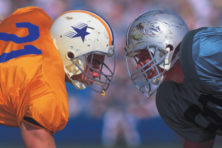Brain Trauma and Soccer: Football Not the Only Sport Battling Concussions
- Share
- Tweet
- Pin
- Share

This piece is a follow-up to last week’s feature, Change in Practice: High School Football Adapts to Concussion Concerns.
When Bill Herbst began serving as the athletic trainer at Gibraltar High School 23 years ago, it was common to hear coaches and parents chuckle and say that a player “got his bell rung” after a collision or fall.
“That doesn’t happen anymore,” Herbst said.
Football is in the midst of dramatic changes to rules and practices all in an effort to reduce concussions and repeated blows to the head, but football isn’t the only sport under the microscope.
“The worst head injuries I’ve ever seen are in soccer,” Herbst said. “I’ve seen concussions, a broken jaw, a player bit through his lip, and broken teeth.”
Tim McGuine, Distinguished Scientist at the Sports Medicine Program at the University of Wisconsin – Madison, produced an influential study on how changes in practice policies have reduced concussions in Wisconsin high school football players. He said the data shows girls soccer is just as problematic as football for high school athletes, with more concussions per participant in girls soccer than in football. There were 142,700 concussions in high school football out of 1.1 million high school football players in 2014-15. That same year, there were 78,490 concussions reported out of 381,529 girls soccer players.
Many point to headers, in which a player will launch a kicked ball off their forehead, as the culprit. As a result players have begun to use headgear more frequently to cushion the blow.
“We’ll see a player or two on every team wear them,” said Sturgeon Bay Girls Soccer Coach Bob Desotelle.
They have not become commonplace, coaches said, in part because players say they find them uncomfortable. McGuine said it’s also unclear if the headgear, which can look like a thicker headband or a wrestling helmet, provides protection. He’s now conducting a study to measure the effectiveness of the gear in preventing concussions.
Desotelle’s team was approached to take part in the study, but to do so required the entire team to wear headgear for the season, and Desotelle could not get consensus from the team to do so. Desotelle is taking other measures to protect his players, including work in the weight room to strengthen upper body muscles.
Concussions are far less common in boys soccer (just 29,386 were reported in 2014-15 in 440,322 players). Some research attributes that to stronger neck muscles in boys.
“Research shows that strength in the trapezoid around the neck is important for preventing concussions,” he said. “If it’s strong, the head is less likely to snap and get whiplash when you hit the ground.”
Todd Maas, now in his 11th year coaching boys soccer at Sturgeon Bay, said good technique also protects against injuries when heading a ball.
“It’s important to use your forehead, not the top of the head, when taking a header,” he said. “You need to engage your neck muscles, generate power from your legs. If you don’t use proper technique you can injure yourself pretty easily.”
But McGuine and the county’s soccer coaches are less concerned about headers than they are about elements of the game that can’t be controlled with technique.
“In the case of headers, the player is prepared for the hit and striking the ball correctly,” said Steve Weitman, an assistant boys soccer coach at Gibraltar as well as a pediatrician and first responder. “When we see concussions it’s when the player isn’t prepared for the hit. When the ball hits the player’s head unexpectedly, or when players bang heads.”
When players launch themselves to head the ball, they are often competing with another player for the same space, resulting in elbows to the head, banging heads together, or awkward landings that smack their head against the ground.
Dr. Bennet Omalu was the first to bring the dangers of repeated head injuries to the forefront in the NFL in 2002, and earlier this month he called for soccer to eliminate headers for the same reason, but there has been little talk of such a move in the high school ranks.
“Eliminating headers would be idiotic,” Maas said, while agreeing that a ban makes more sense at lower levels. “It takes away a very valuable part of the game. If your players are getting hurt too much on headers, it’s probably because you’re teaching it wrong.”
There are other ways coaches, trainers, and even officials are trying to keep players safe. Weitman said it’s common now to hear officials talk to players in the moments before a potential header opportunity.
“When you have two players go up for the same ball, the referees will be very vocal about instructing them to go straight up,” Weitman said.
Weitman and Herbst said it’s more common to see players who eschew headers, preferring to stop the ball with their chest or thigh, or trap it with their foot.
Even without new rules, the game appears to be changing.

